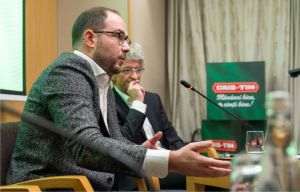
The spiritual potential opened by verse "26. Let us make man in Our image and likeness" (Genesis:1) is supported by the immediately following verse "27. And God made man in His own image; in the image of God He made him; he made male and female", which, in addition to being careful not to discriminate between masculine and feminine, can receive wider meanings, for example that a femininity of God could be assumed, under the name "Shekinah" (which is of the feminine gender) .
Kabbalah developed the idea of femininity of the Shekinah.
The term "Shekinah" comes from the Hebrew root שָׁכַן (shakan), which means "to dwell", "to settle" or "to reside". In the biblical tradition, the Shekinah is often associated with tangible manifestations of the divine presence, such as the cloud that covered the Tabernacle or the flame that burned in the burning bush without consuming it, which Moses saw. The Tabernacle, and later the Temple in Jerusalem, are considered the places where the Shekinah especially dwelt.
In the welcoming ceremony of the Sabbath, there is a tradition to "welcome" the Shekinah, as a bride coming to join the bridegroom, which leads to the verse "5. If a man has recently taken a wife, let him not go to war and let no burden be laid upon him; let him remain free in his house for a year, to make merry with his wife whom he has taken." (Deuteronomy:24)
Beyond the direct meaning of the verse, which commands the release of the groom from any concern other than making his bride happy, it can be seen as initiatic - one sees a connection with the "Binah Yeseirah" (Additional Understanding), which the Talmud (in Niddah 45b, reading Yehuda Ha Nasi), attributes it to women: "This teaches us that the Holy One, Blessed be He, gave women a greater understanding [bina] than that of men".
Taking this carefree year to be with your wife is not only an act of love or familial duty, but also a deep spiritual opportunity for the man to connect with the divine feminine.
In the first year of marriage, Deuteronomy:24:5 exempts the man from war, but also from the work related to war, and, according to the interpretation of some exegetes, also exempts him from taxes and duties: "He shall be free," says Bekhor Shor (approx. 1145 - approx. 1195).
It is a kind of "Personal Sabbatical Year".
Freedom from everyday worries is a condition of spiritual fulfillment.
The idea of liberation appears in the first Commandment of the Decalogue and returns again and again, as a leitmotif, to conclude the Commandments of God, signaling their spiritual character.
a. "I am the Lord your God"
The expression "I am the Lord your God" is repeated dozens of times in various contexts throughout the Old Testament, consistently understood as a declaration through which God asserts His authority over humans, an authority that is implicit in the nature of the Commandments: "55. For unto me the children of Israel are servants; they are my servants whom I brought forth out of the land of Egypt. I am the Lord your God." (Leviticus 25).
In the following, I will explore the variant of the liberating meaning of the expression "I am the Lord your God". It is contrary to the direct sense and difficult to capture unless we consider God as a "savior," as He presents Himself: "6. I am the Lord your God, which brought you out of the land of Egypt, from the house of bondage." (Deuteronomy 5).
If He is a liberator, then enslavement is with regard to freedom. He declares that we are "the servants of freedom."
But what can we assert about the God of Scripture?
b. Divine Tattoo
The Torah and Jesus can be viewed as divine interventions in the human world, without taking into account the specificities of Judaism and Christianity, the different meanings corresponding to these concepts in their respective traditions, where, in both cases, they behave as revelations of the sacred entity they have in common. The fact that they are hierophanies of the same kind brings them together in the verse "17. For the law was given by Moses, but grace and truth came by Jesus Christ." (John 1).
From an unused perspective, the discursive pair in this verse is not made up of Moses and Jesus (since Moses is presented as fully human), but of Law and Jesus, which have divine (and human) nature in common.
But the possible associations on the God - Law - Word - Jesus relationship do not stop there (See "Il Sfumato del Nuovo Testamento" / MAKE / BURSA / April 16).
In Romans 7, the Apostle Paul identifies "νόμος" (nomos / Law) with "λόγος" (logos / Word): "6. But now we are delivered from the law, that being dead wherein we were held; that we should serve in newness of spirit, and not in the oldness of the letter."
That Paul separates Jesus from the Law does not prevent the Evangelist John from establishing the identity between the Word and Jesus Christ:
"14. And the Word was made flesh, and dwelt among us, (and we beheld his glory, the glory as of the only begotten of the Father,) full of grace and truth." (John 1).
In fact, the chapter had begun with the famous verse "1. In the beginning was the Word, and the Word was with God, and the Word was God" (John 1), equating the Word with God.
In a hypothetical (ritual, undesirable) flattening and schematization of the profound aura of discourse surrounding each of the four notions, the resulting equation intersects:
Jesus and the Word;
The Word and the Law;
The Law and God;
God and the Word;
Jesus and God.
One of the conclusions of this way of thinking highlights that Jesus is thought of as the personification of the Law.
This "systematization" of how the four words circulate in the New Testament receives further confirmation from the Jewish side of the Abraham's abrahamic defile, through the late midrash related by Moshe Idel: "Before the creation of the world, there were no hides for the parchment on which the Torah could be written, because there were no animals. And then, what was the Torah written on? On the arm of the Holy One, blessed be He, with black fire on [the surface of] white fire" (1).
The Torah presents itself as a tattoo on the skin of God - an image that confirms the overlap between Law and God, obtained by schematizing the four notions from the New Testament.
c. Texture and Scripture
Those thirsty for certainties regarding God have two complementary options: 1) reality and 2) the text.
c.1. Reality
It is generally accepted as indisputable the existence of billions of believers, the existence of the books they consider holy, the cultural monument erected by exegesis; no one can dispute, normally, the existence of the church, the clergy, the rituals and the influence of all these on history.
Their existence is indisputable to the extent that reality (or what we call "reality") is indisputable (of course, any certainty is questionable).
Being, thus, indubitable manifestations, what is the point of doubting God, even if He were called "Nothing", so that He is not "Something"?
Karl Marx said that arguing about the existence or non-existence of God is simply a waste of time.
That's how it looks.
The important thing is that billions of people relate to Him as an omnipresent third party, a witness in the believer's own mind, in interpersonal and group relationships, a norming and governing landmark, and who thus needs only faith to exist, either as "Nothing".
Reality provides a whole list of certainties, in opposition to the theological and philosophical debates about the nature and/or supernature of God, revealed in the phantasmatic sphere of language that can allow anything, including its own cancellation.
c.1.1. Philosophical Intervention
As long as theology takes care to place God beyond language and reason, beyond the tools of debate, onto-theological debates have limited or even no relevance. Philosophy can deal with many things in connection with God, but God Himself is an improper subject of philosophy.
However, some philosophers of the last century have made an effort to express the lack of perception of the texture of God, offering asylum to the theses of apophatic theology.
For example, Jacques Derrida says: "I am sure that true believers know this better than others because they experience permanent atheism. And I know that great mystics experience this. They experience the death of God or the disappearance of God, God being called "non-existent": 'I pray to someone who does not exist'."
But Emmanuel Levinas is not quite as firm as Derrida presents him because he admits the possibility of knowing God: "God - whatever its ultimate meaning and, in a certain sense, emptiness - appears to human consciousness (and especially in the Jewish experience) "dressed" in values; and this clothing is not alien to His nature or His supernatural nature." (3)
The "supernature" Levinas attributes to God echoes the "superexistence" in the conception of the philosopher John Scotus Eriugena (810 - 877): "God is more than existence."
Eriugena applied here the third way of expression imagined by Pseudo-Dionysius the Areopagite (5th century), who, in order to overcome the dichotomy between "God is wise" and "God is not wise," plunged into "God is more than wise."
About this "third way," Karen Armstrong writes: "[...] it was not about a linguistic trick, but about a discipline that, by juxtaposing two mutually exclusive propositions, helps us cultivate a sense of mystery, represented even by the word we use, "God", since He cannot be limited to a purely human concept" (4).
The procedure is similar to that of the Holy Trinity, in which each Being is the whole God and together they are the One God, which, it is said, deliberately violates the law of logic of identity.
When the certainty of God's existence is evoked in the process of communication, onto-theology is forced to appeal to language devices, including tautologies (as God Himself introduces Himself through "Ehyeh-Asher-Ehyeh"), paradoxes, or even self-contradictions.
As long as these expressions serve a purpose other than communicating the unintelligible thing they say by themselves, they can be understood as landmarks to which reason can advance, but in any case, they are not strangers to linguistic artifice, which eludes an onto-theological assertion.
The appeal to the artifice of language is a rational, metadiscursive decision for reason to mark its own territory, delimiting it from "mysteries" and predominantly emotional experiences (which actually cultivate an unnatural inner dissociation).
c.2. The Text
There are more demanding individuals who, in order to ensure the existence of divinity, would prefer a physical confrontation with an angel, like the one depicted in Paul Gauguin's painting "Vision After the Sermon," or at least face-to-face meetings, as reported in the encounters with Moses in his tent after leaving Mount Horeb.
For personal confrontation, they have at their disposal the Holy Scriptures, and at least the Pentateuch, which is recognized by both Jews (and Samaritans) and Christians as a revealed text. However, the postulation of the text's holiness is not necessarily convincing for atheists; instead, as found in the Kabbalah, what is persuasive is the study of Scripture, where faith is not required but good faith: "You do not respect Me, and you do not study the Torah: You can not respect Me, but you must study the Torah, because in its light, you will find Me."
For the process of thought and understanding, these landmarks scattered through language devices have an uncertain status; the language devices do not belong to discourse, although they use sememes. They do not transfer corresponding experiences to the meanings of language but rather limit discourse. They could be called "discursive limitations," which could be treated bivalently as: a) alien to meaning (perhaps similar to the assumed externality we call "reality"); b) as sememes of a text.
The integration of "discursive limitations" - linguistic devices - into the text opens up some possibilities for "direct contact" with the non-human, as it allows linguistic speculations on what is not an idea (of course, we find ourselves in the realm of the non-rational).
One of the luckiest speculations of this kind takes advantage of the common Latin etymology of the words "text" (5) and "texture" (6), both derived from "texere" - "to weave, to unite, to fit together." According to the "Online Etymology Dictionary," in medieval Latin, "textus" means "Holy Scriptures, text, treatise," while "textura" means "fabric, texture, structure."
It is fortunate that the text is discursive, while the texture is quasi-objectual, and both derive from "to fit together." The etymological coincidence between "Holy Scriptures" and "texture" suggests an onto-theological scriptural perspective.
The idea that the Torah has the "texture of God":
"And then, on what was the Torah written? On the arm of the Holy One, Blessed be He, with black fire upon [the surface of] white fire" (See a. Divine Tattoo).
Somewhat, this idea is less toxic than substituting God with the working class, and in any case, it intellectually engages us in experiential situations (corresponding to the discipline referred to by Karen Armstrong, that "it helps us cultivate a sense of mystery").
d. Yahweh Yasha/God the Savior
The orientation that allows an intersection of meaning between the spheres of the words God - Jesus - Law - Word alludes to an ineffable texture of spiritual elevation.
For those who cannot bear the "Nothingness" behind the word God ("Everything," "Supernature," "More than the wise," "Absence," "Emptiness," etc.), the Scripture - which is an undeniable certainty - offers its "texture," the "consecration" of which is undeniable.
This "consecration" comes from reality and its list of certainties invoked before - the believers, their books, exegesis, clergy, church - but also from the efforts of all to achieve holiness, infinity, perfection, fullness, and splendor.
Whether they are immanent or attributed, in any case, elevated from the Earth, the meaning of the world and the purpose of each in it are presupposed in the weave of Scripture.
The dogmatic experience triggered by the reading of Scripture evokes the "heavenly texture of the text."
What is the name of the angel of the Torah?:
Is it Elijah, the one sent by God to descend upon the student to enlighten his understanding of the Torah?
Or is it Maghid, the one who does not preexist but comes into being when delving into the study of the Torah in order to interpret it?
The dispute over the name is of no importance in relation to the meaning of the message and the functions of Scripture.
The aspiration to which Scripture responds (whether inherent or inspired) can be proposed as the "texture" of God, corresponding to Mircea Eliade's definition of "sacred" as "an interruption of daily reality, whereby something from the profane world signifies or becomes a manifestation of something that transcends this reality."
The proposed perspective sheds a special light on the first Commandment of the Orthodox Decalogue (8):
"6. I am the Lord your God, who brought you out of the land of Egypt, out of the house of slavery.
7. You shall have no other gods before me." (Deuteronomy 5).
The Commandment is the Scriptural basis for refusing to worship the Roman emperor in the guise of a god - God, Augustus, Caesar (9) - as attested by the inscription on the Roman coin from the time of Jesus, freeing from any earthly dominion.
Furthermore, "No one can serve two masters" (Matthew 6:24 and Luke 16:13).
We notice that the Commandment no longer signifies the transition from Egyptian slavery under a personal God, but it points to salvation that is found in the "text" - absolute liberation, for the purpose of spiritual elevation.
It is not a choice between two masters but the liberation from any master, as "the slave of an aspiration" is a different definition of freedom.
The transition from the "house of slavery" to the "house of freedom."
This can be the meaning of the verse from Leviticus 25:42:
"39. And if your brother becomes poor beside you and sells himself to you, you shall not make him serve as a slave:
40. He shall be with you as a hired worker and as a sojourner. He shall serve with you until the year of the jubilee.
41. Then he shall go out from you, he and his children with him, and go back to his own clan and return to the possession of his fathers.
42. For they are my servants, whom I brought out of the land of Egypt;"
My servants, meaning Servants of My Freedom.
Freedom, but not arbitrary, corresponding to the idea of a slave of God, in which God can receive the specific name of "Yahweh Yasha" (יַהְוֶה יָשַׁע)/"God the Savior" - "The Deliverer".
A servant of God can mean more than a free person; it can mean the holy status of a free person.
With this liberating meaning of the first Commandment of the Decalogue, I will articulate it to the central thesis of the Kingdom of God - "Man has the status of a spiritual being" - adding to it "In complete freedom," as a subordinate and conditional thesis.
The two theses can be combined into a single proposition - "Man has the status of a spiritual being in complete freedom" - but they are two different aspects of a progressing process, waiting to be supported by subordinate norms.
The fulfillment of the "Kingdom of God" demands economic freedom - a whole chapter ready to be integrated: Shmita and the Jubilee,
particular cases of Tzedakah.
Notes:
(1) "Kabbalah and Interpretation"/page 69/Moshe Idel/Polirom/2004
(2) Film "Absent God - Emmanuel Levinas and the Humanism of the Other"/2014/minute 28:21
(https://www.youtube.com/watch?v=qbGaXEqxSvU)
(3) "Nine Talmudic Readings"/Towards the Other"/pages 14-15/Emmanuel Levinas/Indiana University Press/BLOOMINGTON & INDIANAPOLIS/1990)
(4) "A History of God"/page 239/Karen Armstrong/Nemira/2009
(5) "Text" - At the end of the 14th century, "formulation of any written thing," from Old French "texte," Old North French "tixte" meaning "text, book; Gospels" (12th century), derived from Medieval Latin "textus" meaning "Holy Scriptures, text, treatise," and Late Latin meaning "written account, content, characters used in a document." This formation comes from Latin "textus" which means "style or texture of a work," literally meaning "woven thing." The Latin term is based on the past participle form of the verb "texere," meaning "to weave, to unite, to fit together, to braid, to construct, to fabricate, to build" (derived from the Proto-Indo-European root teks- meaning "to weave, to fabricate, to make; to make a framework of twigs or straw").
(Online Etymology Dictionary)
(6) "Texture" - In the early 15th century, "network, structure," from Latin "textura," meaning "texture, structure," derived from the root of the verb "texere," meaning "to weave" (from the Proto-Indo-European root teks- meaning "to weave, to fabricate, to make; to make a framework of twigs or straw"). The sense of "structural character" is recorded from the 1650s.
(Online Etymology Dictionary)
(7) The etymology of the word "consecration" suggests sanctification as a collective process: "To consecrate," from Latin "consecrare" meaning "to make sacred," from "con-" meaning "together" and "sacrare" from "sacrum."
(8) For Jews, the two verses correspond to the first and second Commandments; for Catholics and Lutherans, the first Commandment includes the prohibition of graven images. Among the various Abrahamic denominations, the Commandments are distributed differently, but in all of them, the prohibition "You shall have no other gods before me" is included; in an implicit form, it is also present in Surah Al-Baqarah:255 of the Quran: "There is no god but He, the Living, the Eternal!" (The Quran, page 44/Publisher: Herald/Bucharest/2005).
(9) See "d) Survival under foreign occupation" from "Ieşirea de sub tutela lui Dumnezeu"MAKE/BURSA/12-15 August 2022.
Post Scriptum
The essay does not end here, but the next episodes will probably be published by Christmas.
At this moment two more chapters are being written, and the conceptual construction of the Kingdom of God is already done, bringing several dozen commandments into a functional structure.
All the pieces, however, required explanatory derivations, revisions and possibly reworkings.
I hope that the three-month break until the Winter Holidays will be enough to be able to present them to the public.
- The author
Episode I: THE TRIUMPH OF MAN (I) - Disapproval does not suspend the study
Episode II: THE TRIUMPH OF MAN (II) - Rabbinic democracy
Episode III: THE TRIUMPH OF MAN (III) - The coup for the landing of God
Episode IV: IMPROVEMENT SUPPRESSES THE IDEAL - The bloody disjunction between the "Kingdom of God" and "Tikkun ha Olam"
Episode V: IMPROVEMENT SUPPRESSES THE IDEAL (II) - "According to the image and likeness"




















































